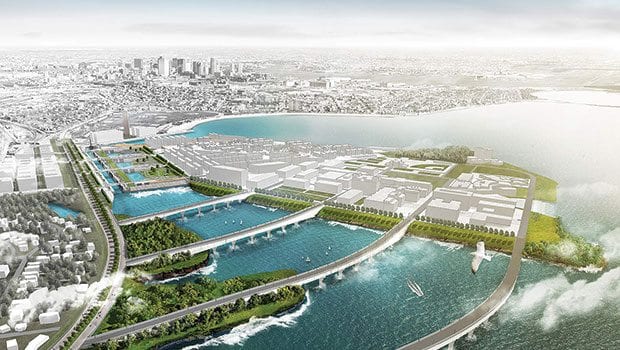Architects tackle challenges of rising sea levels
Competition seeks to help Boston cope with effects of climate change

A forward-looking planning competition called Boston Living with Water has turned its attention to the rising sea level and highlights the importance the architecture, design and urban planning industry will have in ensuring the city’s survival. The message is pretty clear — it’s going to be sink or swim for many of Boston’s critical economic and business hubs.
Sparked by climate change stats that highlight a 12-inch rise in Boston Harbor sea water levels in the last century and predict about a five-foot rise by 2100, the Boston Living with Water competition tapped some of the world’s brightest architecture and design minds to figure out a way to help Boston prepare for what promises to be chronic future flooding in at least 30 percent of the city.
Kicked off last fall and led by Mayor Martin Walsh’s staff, The Boston Harbor Association, the Boston Redevelopment Authority and the Boston Society of Architects, the competition received submissions from 50 teams from eight different countries. Recently, a jury narrowed down the entries to nine finalists who will compete for a $20,000 grand prize to be awarded in June. The prize is funded by the Massachusetts Office of Coastal Zone Management and the Barr Foundation.
Competition organizers narrowed the focus on three distinct areas of the city that each present a different challenge — a building, an entire neighborhood and a large piece of city land. These sites were Prince Building in the North End, Morrissey Boulevard in Dorchester and the 100-acre neighborhood of Fort Point.
However, as Senior BRA Architect and Boston Living with Water lead John Dalzell attests, the main point is to start collecting architecture and design concepts that can save the Boston of our children and our children’s children from being swallowed by the sea.

Author: Photos courtesy of Boston Living with WaterDetail views of the Hydrokinetic Canal.
At A Glance
“Resilient Linkages” – This proposal attempts to balance the immediate pressure for development in Fort Point with the long-term understanding that the area will be prone to regular flooding in the future. The plan would establish a new, elevated street grid and require developers to integrate supportive infrastructure for sea level rise into their projects, which could then be linked to form fully-functional, neighborhood-scale infrastructure.
“Water District” – This proposal would raise the entire base and infrastructure of the 100-acre neighborhood by approximately 12 feet, matching the raised elevation of historic Summer Street and creating a resilient development area to serve as a model urban waterfront district for the 21st and 22nd centuries.
“The Hydrokinetic Canal” (Above) — This proposal for transforming Morrissey Boulevard and Harbor Point over the next 100 years draws inspiration from the topographic and land-use patterns of 17th century Boston. A new system of waterways would be created to increase Columbia Point’s resilience to climate change, generate sustainable energy, and provide an expanded, improved public realm. A new Hydrokinetic Canal is this urban plan’s centerpiece.
Boston Living with Water
For more information, visit: www.bostonlivingwithwater.org
Future resilience
It’s not just about staving off the flood — a large wall or dike could do that. The point is to envision a better Boston, one that thrives with more sustainable and environmentally-sound city design.
“We are asking the best people to give us their thoughts, to tell us what will be the best path forward,” said Dalzell. “What we have are very futuristic visions but some are very pragmatic and that is what we are looking for … We are looking for feasible solutions, things that can be implemented.”
The Living with Water competition yielded some unique and cutting-edge ideas. It highlighted the kind of innovative thinking that could put the city — already known as a hub of architecture and design, thanks to area world-class colleges and universities — on the forefront of showing how cities can address rising sea levels.
From the “The Prince Building Piers” submission that envisions streetscapes surrendered to the sea in a new urban seashore, to the “Water District” proposal that suggests raising the entire base and infrastructure of Fort Point by about 12 feet as a new model urban waterfront, to “The Hydrokinetic Canal” project that suggests transforming Morrissey Boulevard and Harbor Point with a new system of waterways that would increase resiliency to climate change and generate sustainable energy, all the final projects showcase groundbreaking thinking applicable throughout Boston.
While many residential neighborhoods face a perilous future, the economic impact of rising water levels is critical to the city’s survival as well.
Dalzell pointed to the one-time fury of Hurricane Sandy to illustrate the impact of sea water on a major metropolitan area. While the physical damage was astronomical, the economic impact was worse. Some estimate that as many as 60 percent of the businesses that did not reopen within two weeks of the storm closed permanently.
Not just surviving
Dalzell said Boston’s businesses need to remain competitive in the future in the face of rising sea level and climate-driven threats, not just survive and struggle through a bad situation. The only way to do that is to plan ahead.
Gretchen Schneider Rabinkin, director of civic design for the Boston Society of Architects, points out that even for the winning proposal the prize money does little to cover the cost of the amount of time the teams put into their submissions. But from a professional view, it allows them to further pursue crucial environmentally-driven concepts.
She said there is little doubt the competition participants see the potential in this kind of work as cities all over the world face climate change challenges. Those that understand how to address these issues are in increasing demand now and will continue to be.
Ellen Watts, founder of Boston-based architecture firm Architerra and a finalist with its “Water District” proposal, said her firm focuses on sustainability and environmentally responsible building. The competition was an extension of what they already do, but also a real chance to stretch their imagination.
“There is no question that green design, resiliency planning and sustainable advancement is not just a good idea. It is essential and with it will come business opportunities,” Watts said.
“I have to say when we started our firm in 2004 that did not seem self-evident … but that is starting to evolve and we are seeing that already.”
Alan Mountjoy, a partner at the large architecture, planning and design firm NBBJ, which has offices all around the world including in Boston, led the team for the “Resilient Linkages” proposal and called the efforts important for staff development.
His team was able to get a better understanding of how environmental factors such as rising sea water levels can drive project design. NBBJ currently is doing more of this work in other parts of the world, but relished the chance to turn the focus back to a home office in the U.S.
“It was an opportunity for us to improve our understanding,” Mountjoy said. “Everybody is going to have to be involved in this in the future.”






